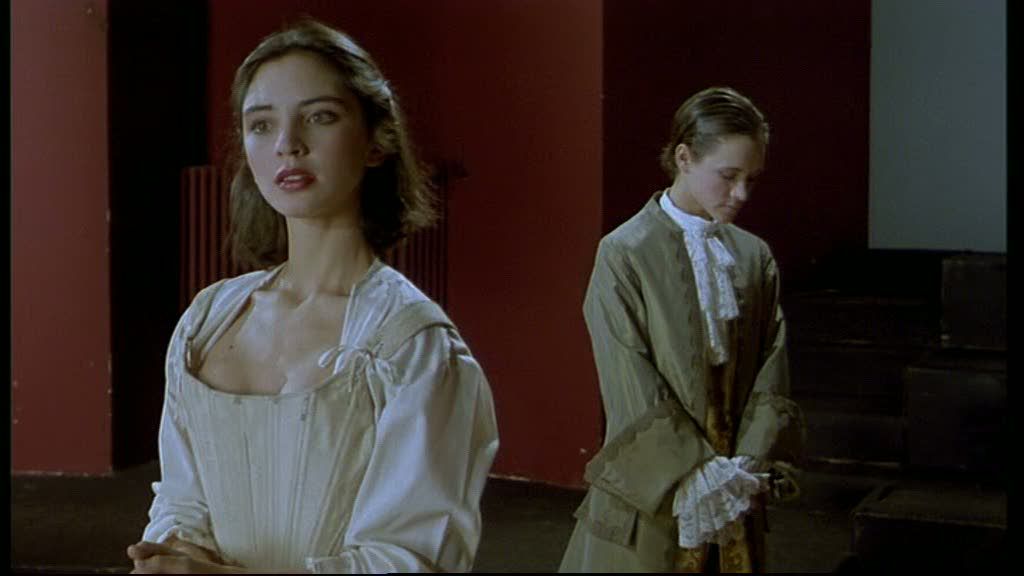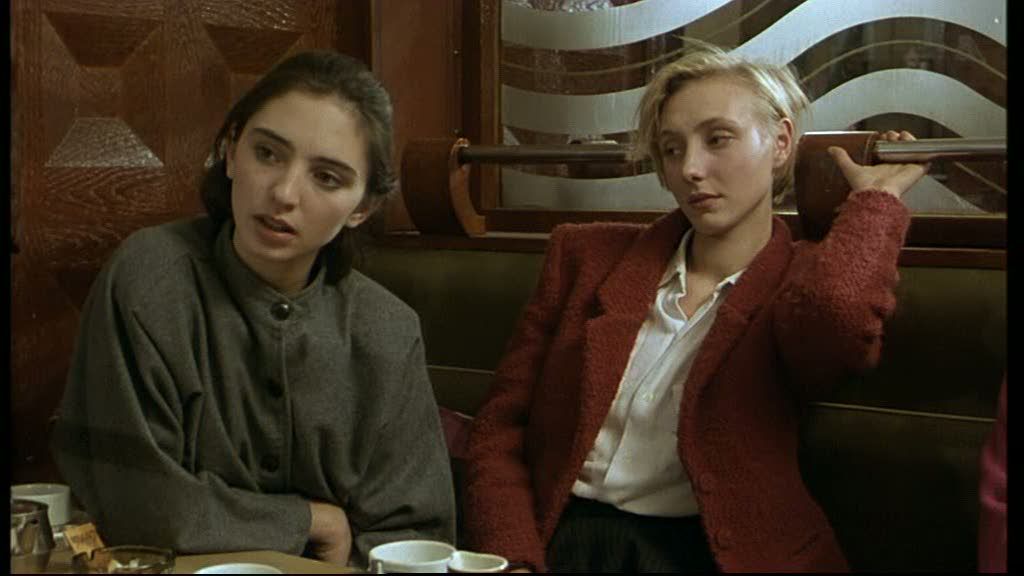
Jacques Rivette's 1988 film Gang of Four is a kind of summation of the elusive auteur's style and thematic concerns, a skillful variation on the various threads that wove through his work of the preceding three decades. It encompasses his passion for the theater, his taste for esoteric conspiracies with many dangling loose ends, his way of using acting and dramatization to peel away the layers of a character over time, his playful improvisatory spirit and fondness for whimsical ghost stories. The film is a deliberately paced — but never plodding — character study of a group of young girls studying acting under the watchful eye of the demanding instructor Constance (Bulle Ogier). The main action especially centers around one particular quartet of girls living in the same house: Anna (Fejria Deliba), Claude (Laurence Côte), Joyce (Bernadette Giraud) and Lucia (Ines d'Almeida). When the film opens, Lucia is just moving in, replacing Cécile (Nathalie Richard), who is moving out but not leaving the acting class.
With his keen eye and slow, sweeping camera moves, Rivette methodically explores the characters of these disparate young women, weaving serpentine plots around them and suggesting vapor-like hints of back stories. Anna, it turns out, is actually named Laura; she's taken the name of the vanished sister who she has been searching for. The bisexual, androgynous Claude is tormented by unrequited love and is desperate for meaningful connections. The tiny, porcelain-pretty Lucia is exiled from her home in Portugal, where she disgraced her family by refusing an arranged marriage and drinking down a few sips of poison in a suicide attempt; she keeps the unused portion of the bottle in her room as a "souvenir." These hints of the past remain largely unresolved, peripheral elements in a film dense with detail and nuance. The girls are soon drawn in by a mysterious plot of some kind involving their friend Cécile's boyfriend Antoine, who's involved in some shady and possibly criminal business. The girls can see that Cécile is increasingly distracted and upset, her acting affected by the troubles of her outside life, and their suspicions are heightened when a cagey guy (Benoît Régent), possibly a cop, starts snooping around and asking questions about their friend. Not that he's any help, really: he keeps changing his name, before finally settling on Thomas, and tells each of them in turn a different outrageous story about what underworld activities Cécile and Antoine are involved in (fake IDs, gun smuggling, art thievery).
Rivette, of course, is sympathetic to the chameleonic Thomas, even though he's kind of a manipulative jerk. Rivette also cares little for the concrete details of such conspiracies; all that matters to him is the suggestion of something there, floating like smoke on the fringes of the narrative, a catalyst for everything that follows. As the girls dance around this mystery, trying to help their friend, art and life blend into one another. The play they're rehearsing — Marivaux's La double inconstance — comments obliquely on the lives of the girls, with its themes of double identities, unconsummated desires and imprisoned lovers.
Thus, when Constance leads her class through rehearsals, she is preparing them not just for the play but for life — towards the end of the film, she abruptly departs, leaving them on their own, as though she had been leading them towards this self-sufficiency all along. Rivette's emphasis on acting similarly blurs the line between what's artifice and what's "reality." He views acting, not as pretend or lies — as the bitter Claude does — but as a way of getting at deeper truths. The rehearsals cycle around endlessly, with Constance instructing her students in seemingly contradictory ways: pay attention to the written lines, put more emotion into it, tone it down, make the ideas obvious even to the back rows, don't be so obvious. Her mode of instruction frustrates the girls, who are paying a lot of money to be enrolled in the best acting class in Paris, but they seem to understand that she is pushing them towards something concrete, trying to get out of them performances that feel real.

On a metafictional level, Rivette is doing the same thing, and he lets his film's narrative ramble at a leisurely pace in order to give the actors room to breathe, time to fill in the nuances of their characters. Their personalities come out equally whether they're on stage for Constance or simply on screen for Rivette, and one senses multiple levels of acting filtering through each of them: the film actress playing another actress who's playing a part in a theater. And at the same time, these levels are also one, with no distinction made between the woman on stage, the woman in Rivette's film, and the woman who, presumably, exists off the set when the filming stops. Rivette is, as always, interested in these intersections of identity, and Gang of Four, as with all his films, gives the impression of watching something slowly take shape over the course of nearly three hours. Rivette's films are as much about the process of making themselves as they are about anything; Gang of Four is equally about producing a play, creating a film, and solving a mystery, not necessarily in that order. Indeed, Rivette purposefully leaves most of the film's mysteries dangling, unsolved, giving the final word instead to the play within the film: when the play ends, so does the film.
All of this metafictional gamesmanship is accomplished with Rivette's usual playful brio and understated humor. The acting class is always lively, and Rivette's camera wanders freely around the room, sometimes framing those on stage in strikingly dramatic compositions, other times darting off into the theater seats, where the girls who are watching whisper and joke. Rivette's compositions shift fluidly between very rigid formalist constructions and looser, more relaxed arrangements. Often, there's tension within the frame between the stagey blocking of the actors and the casual scattering of background details. There's even a running gag with one punky, disinterested student who's always either stumbling in late or sneaking out early in the background of the shot.
As much as Rivette worships the theater and the art of acting, he's not afraid to be irreverent and silly as well. One of the film's best scenes is a hilarious sequence in which Anna, Claude and Joyce act out a trial for the benefit of Lucia, each of them taking on multiple parts and signifying their role reversals by placing one of several multi-colored coffee mugs on top of their heads like hats. It's a great scene that encapsulates one of Rivette's most endearing qualities, his willingness to let his actresses have fun and cut loose; there's a semi-improvisational quality to this scene, and especially to the halting, off-key song they sing at the end of it, that makes it feel a break in the film's narrative. And yet this scene's broad satire of the justice system also ties in with the story of Cécile and Antoine, as well as with the Marivaux play the girls are rehearsing with Constance.
Gang of Four is a typically enthralling and enchanting film from Rivette, a complex game of a film in which the rules are obscure and the pieces move unpredictably. More than anything else, however, it's a showcase for the charming young actresses Rivette has cast here. Their smart, witty performances are never less than fun to watch, and as the film progresses, each of these girls invests her character with greater and greater depths. This is a pure celebration of acting as the finest art: the art of finding (and embracing) the mystery and drama in life.

3 comments:
It's been several years since I've seen this film, but if I recall there was a scene where Thomas relates the story of the painter Frenhofer and his last masterpiece. It's a reference to Balzac's Le chef-d'oeuvre inconnu ("The Unknown Masterpiece"), but Thomas -- again, forgive my sketchy memory -- is talking about Frenhofer as if he were an actual person. Three years after Gang of Four, Rivette filmed the Balzac story as La Belle noiseuse
You know, I probably should have realized that. But you're right, one of the stories Thomas tells is about Frenhofer and a missing painting that no one has ever seen. Of course, like everything else Thomas tells the girls in the film, this turns out to be a lie. Very interesting, Flickhead, thanks for pointing that out.
With his keen eye and slow, sweeping camera moves, Rivette methodically explores the characters of these disparate young women, weaving serpentine plots around them and suggesting vapor-like hints of back stories.
Great stuff here. I'm sorry to say this is one Rivette I haven't gotten to, even though it was copied for me about six months ago from a fellow cinephile. As always your complete command of this director's style and essence is an eternal enlightenment. Of course the above-mentioned LA BELLE NOISEUSE of one of my favorite Rivettes, as I'm sure it probably is one of yours as well.
Post a Comment